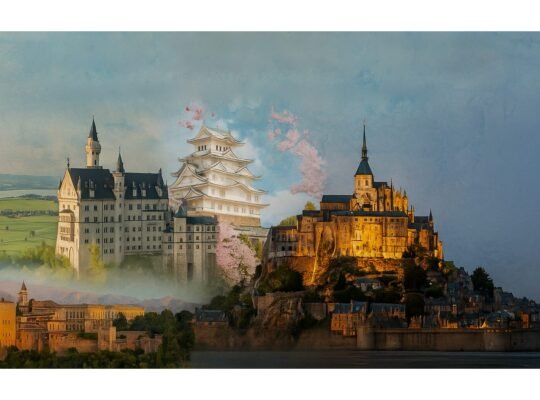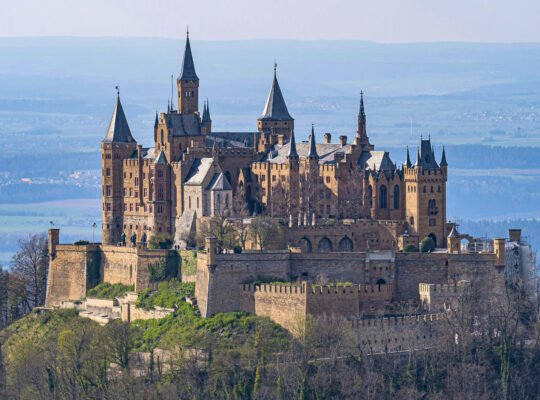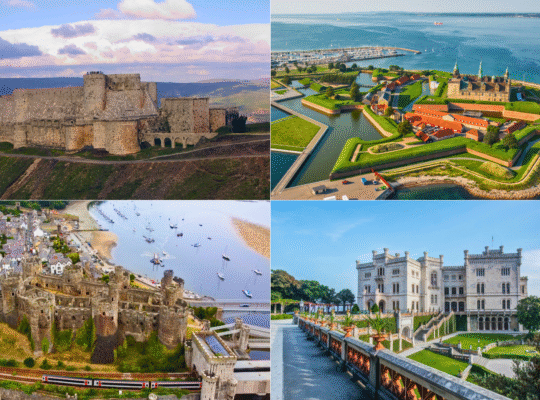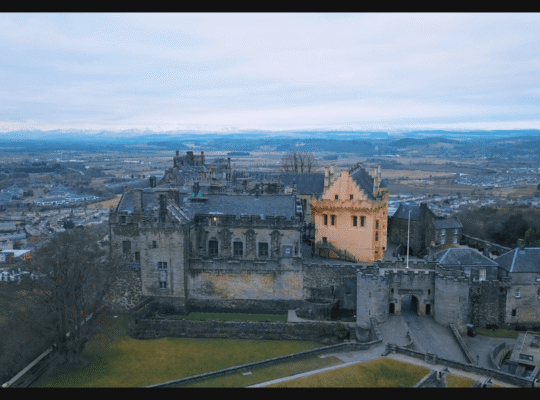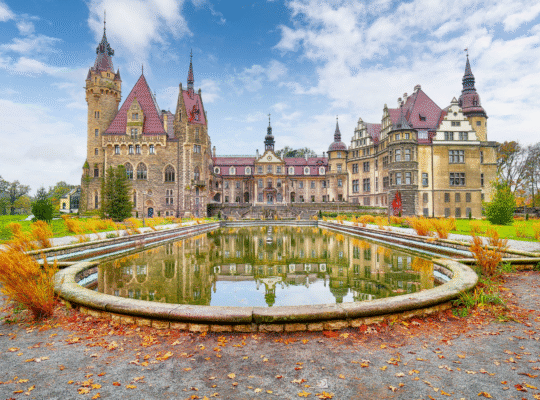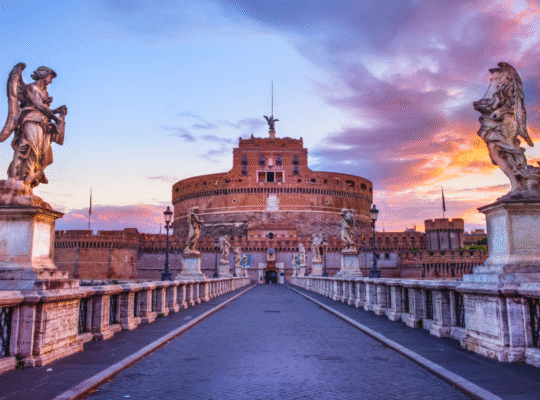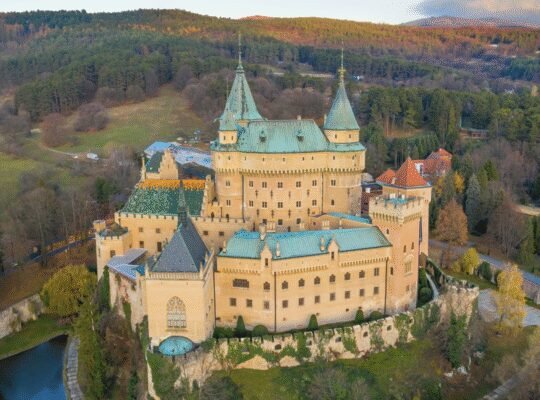I have to admit, I never expected a castle to leave me lost for words. But the first time I set eyes on La Mothe-Chandeniers, I stood frozen at the edge of the old moat, half convinced I’d stumbled onto a movie set left behind by a crew who’d packed up and forgotten to yell “cut.”
Maybe it was the way the mist hugged the broken turrets, or the shock of green vines clawing up rose-stone walls that have seen centuries of love, war, and neglect. Or maybe it was the knowledge—passed from a grinning local guide as we wandered toward the drawbridge—that this castle nearly vanished for good, only to be saved by tens of thousands of strangers scattered across the globe. The legend says its last resident was a stubborn little dog who wouldn’t leave after the fire, refusing to abandon a home that had been lost to everyone else. It’s hard to shake the image of that kind of loyalty.
La Mothe-Chandeniers is not your usual French château. It’s a ruin, yes, but it’s also a living experiment. Step inside and you won’t find velvet ropes or guards with practiced smiles. Instead, you’ll hear birdsong where ceilings once stood, and you might catch the laughter of volunteers repairing walls stone by stone. It’s a place that draws you in and makes you wonder: how many secrets are still hiding in the cracks? How many more stories are waiting to be told?
What follows is everything I wish someone had told me before my first visit: the practical, the magical, and the utterly unexpected. If you’ve ever dreamed of touching living history, this is your invitation.

Quick Facts: La Mothe-Chandeniers at a Glance
📍 Location: Les Trois-Moutiers, Vienne, Nouvelle-Aquitaine, France
🏗️ Construction Period: Originally 13th century (medieval); rebuilt and embellished multiple times (notably 19th century)
🏰 Architectural Style: Romantic Neo-Gothic with Medieval foundations
🎭 Famous For: Dramatic ruined beauty, surrounded by a wide moat; miraculous survival after the 1932 fire; symbol of global crowdfunding and community restoration.
👑 Notable Owners: Bauçay family (medieval lords), Leclerc de Ladouze, Baron Edgard Lejeune, thousands of co-owners via crowdfunding (since 2018)
🏆 Restoration Status: Ongoing—saved from ruin by 27,000+ co-owners from 115 countries; active preservation and creative revitalization; not a UNESCO site (yet), but celebrated as a people-powered heritage landmark.
🌐 Official Website: https://www.mothe-chandeniers.com/
Bonus tip: Bookmark the official website above for current hours, ticket booking, and special event updates before your visit.

The Story of La Mothe-Chandeniers: History & Legends
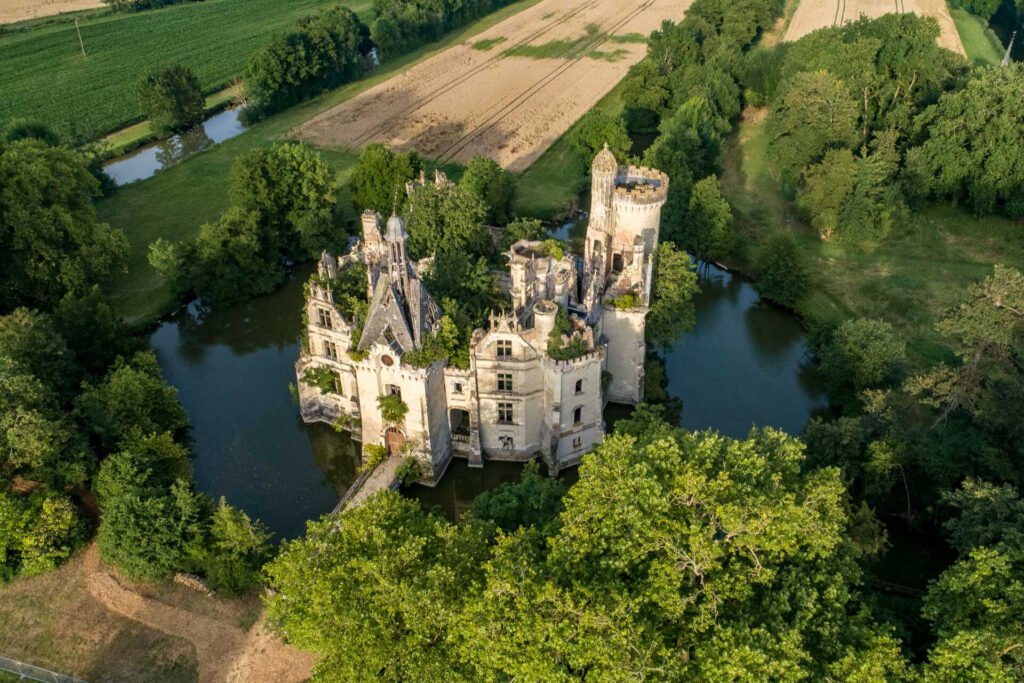
La Mothe-Chandeniers doesn’t play by the usual castle rules. Its story is a mess of heartbreak, stubborn hope, and a few legends that sound almost too strange to be true.
The first time I heard about the place, I pictured just another Loire Valley château. Then I learned its history is more of a patchwork quilt than a family tree. The earliest stones went down in the 1200s, set by the Bauçay family. Back then, it was all about defense—a moated stronghold in the middle of wild marshland. Over the centuries, the castle changed hands and faces, sometimes a nobleman’s retreat, sometimes a target for whatever army or revolution was passing through. It survived invasions, expropriations, even the odd royal visit.
Fast forward to the 1800s, and everything changed. Baron Edgard Lejeune, a man with deep pockets and even deeper romantic ideas, bought the property. He didn’t just renovate; he practically reinvented the castle. Spires, balconies, glassy windows—he transformed the crumbling medieval fortress into something out of a storybook. Locals talk about the wild parties and the gardens bursting with roses. It was the golden era for La Mothe-Chandeniers.
Then came the fire. If you talk to anyone in the area who remembers the old days, you can feel the disappointment in their voice. In 1932, a fire tore through the château. People watched helpless as flames ate through centuries of woodwork, artwork, and memories. The stone shell survived, but nearly everything inside was lost. Afterward, the place just sat—too expensive to restore, too beautiful to bulldoze. Nature took over. Trees grew in the ballrooms, moss crept across the walls, and the moat quietly filled back in. At some point, even the wildlife seemed to claim it. Someone told me about a stray dog who kept living in the ruins long after everyone else gave up. Depending on who you ask, the dog is still there, haunting the grounds out of pure loyalty.
For decades, the castle stood as a kind of local secret. Brave teenagers snuck in for midnight dares, photographers hunted for the perfect “forgotten France” shot, and the occasional dreamer would ask about buying it—always giving up after seeing the work involved.
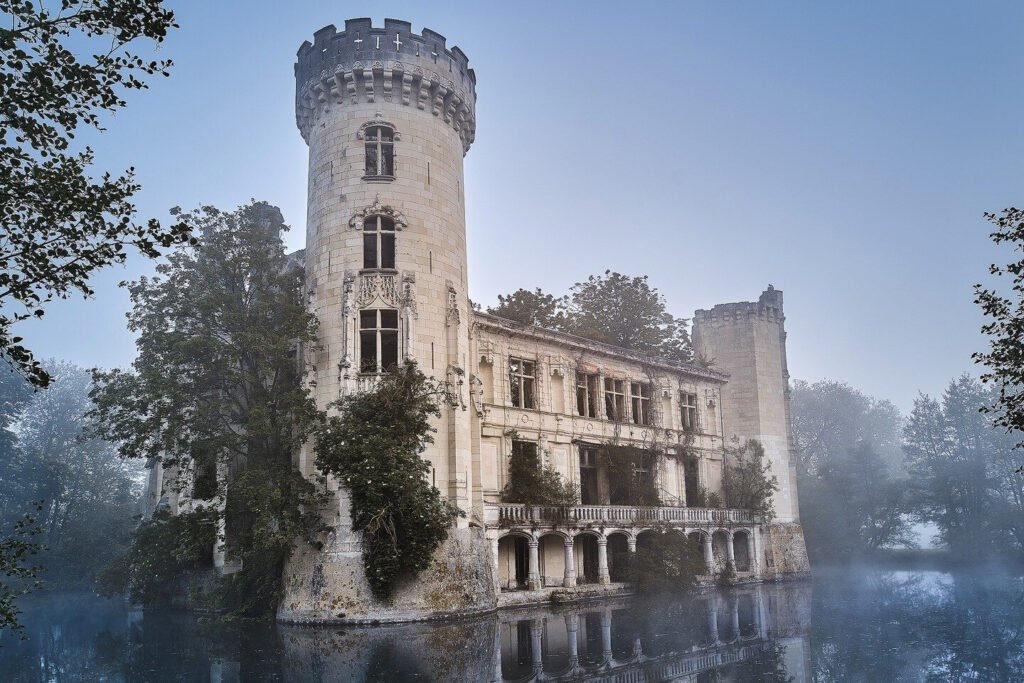
And then, out of nowhere, the story took a left turn. In 2017, a little French company called Dartagnans announced a plan: buy the château not for one owner, but for the world. People from everywhere threw in a few euros. Suddenly, La Mothe-Chandeniers had over 27,000 co-owners from every corner of the globe. The media called it a “crowdsourced miracle.” For once, the headline wasn’t about a heritage site vanishing, but about thousands of strangers rolling up their sleeves to fix what everyone else had left for dead.
Since then, restoration has moved at its own pace—part professional, part volunteer, always with a sense of shared adventure. New legends are taking root: the American who flew in for a work weekend, the wedding held in a half-restored chapel, the day volunteers unearthed a centuries-old tile beneath a tangle of brambles. Even with hard hats and scaffolding, the place has kept its mystery.
People still whisper about secret passageways under the moat and hidden gold lost during the Revolution. Who knows if any of that is true? What’s certain is that La Mothe-Chandeniers, once nearly erased, has come back in the most unpredictable way—a castle now powered by its crowd of caretakers, each one adding their own thread to a very long, very unfinished story.

Architecture & Atmosphere

Some castles impress you with grand facades and meticulous gardens. La Mothe-Chandeniers? It grabs you by the heart before you even cross the moat. I remember the hush that falls as you approach—the kind of quiet where you hear your own footsteps crunching gravel and a distant coo of wood pigeons from the surrounding trees.
Visually, the place is a beautiful contradiction. From a distance, you see turrets and towers straight out of a fairy tale, softened by ivy and roses gone wild. Get closer, and you’ll notice broken windows, weathered stonework, and places where nature has crept inside. The castle sits on its own island, circled by a broad moat—some days, the water reflects the sky so perfectly that the ruins seem to float. Other times, it’s just a mirror for tangled branches and half-fallen walls.
There’s no single architectural style here. The core is medieval—a proper fortress, thick walls and all. But the flourishes came later: 19th-century Gothic windows, elegant balconies, pointed roofs, and the unmistakable sense that someone wanted this place to be romantic, not just safe. A walk around the perimeter gives you flashes of the old and the new: the original keep, crumbling but defiant, right beside whimsical stone details added by Baron Lejeune in his glory days.
Step inside—if restoration work allows—and the mood shifts. Sunlight pours through empty frames where glass once gleamed. Some rooms feel almost open-air, with saplings reaching for the light and wildflowers poking up through old tiles. It’s equal parts ruin and rebirth. I caught myself staring up at a ceiling now entirely replaced by sky, half-expecting to see a hawk glide overhead. The main staircase, though battered, still hints at past elegance with its gentle curve and carved banister.

Small surprises are everywhere. A wooden bridge that bounces slightly underfoot. Faded traces of painted murals. The sweet scent of damp moss mixed with old stone. And if you look closely, you’ll spot the careful work of volunteers: a restored window here, fresh mortar there, new paths gently guiding you through the wildness without taming it.
Most of all, La Mothe-Chandeniers feels alive—not because it’s polished, but because it’s still changing. It’s the only castle I’ve visited where you can literally see the line between ruin and renewal. One step, you’re in a crumbling salon. The next, you’re admiring a lovingly restored doorway or catching sunlight glinting off the moat. It’s unpredictable, honest, and utterly unforgettable.

Visiting La Mothe-Chandeniers: The Essential Guide
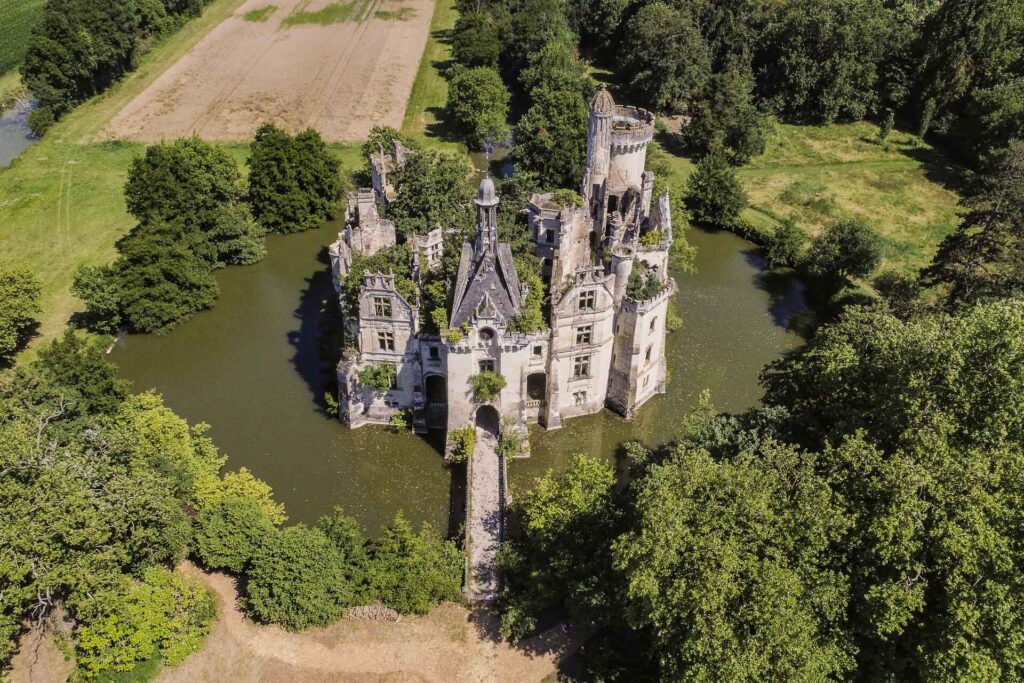
🛣️ How to Get There
I’ll be straight with you: La Mothe-Chandeniers is off the beaten path, and that’s half the fun. I set out from Poitiers, picked up a tiny rental car, and followed those winding rural roads, fields on either side, until my phone lost signal just outside Les Trois-Moutiers. (Don’t panic. If you see cows, you’re going the right way.) From Paris, you can hop on a high-speed train to Poitiers, then drive the last stretch. Saumur is another handy starting point—also about forty minutes away by car. If you’re coming from Tours, allow just over an hour. There’s no direct public bus to the castle, so I’d strongly recommend renting a car for the last bit. Parking is free and simple—you’ll spot the signs just before you reach the moat.
🎟️ Entry, Tickets & Tours
I recommend booking your ticket online. It’s quicker and usually a little cheaper than paying at the gate. Standard adult admission last time I checked was €10, with discounts for kids and families. Always check the official website before you leave, though, because prices can change for special events. Most of the time, you’re free to explore at your own pace. On certain weekends and holidays, volunteers offer short guided walks or themed tours—check the schedule online or just ask at the entrance. Information panels in French (and some English) fill in the backstory as you wander.
📅 Best Time to Visit
My personal favorite time is spring. The moat is full, the gardens start popping with color, and the sun catches the castle just right. Early autumn is a close second—cooler, golden light, fewer people. If you can swing a weekday visit, it’s extra peaceful. Summers are lively, especially during festivals or when volunteers are on-site. I’ve visited on a chilly February morning and found myself alone with the birds and the sound of wind in the trees—not everything is open in winter, but the atmosphere is hard to beat if you’re into moody photos.

🍽️ On-Site Amenities
Food here is simple and local. There’s usually a little food truck or pop-up café on busy days, offering sandwiches, cakes, and coffee. If you’re lucky, you might catch a local market stall out front. I always pack a picnic just in case—there are plenty of benches with a view of the castle. Restrooms are clean and close to the entrance. The small gift shop sells souvenirs, books, and even shares in the castle if you want to join the crowd of co-owners. Parking, as I mentioned, is free and a short stroll from the bridge.
♿ Accessibility
Don’t expect flat, paved walkways. The grounds are mostly gravel, and some paths are bumpy. That said, you can reach most of the main circuit and the gardens without too much trouble. There are a few steps at the bridge and uneven spots, but staff are happy to help where possible. I’ve seen visitors with strollers and even a wheelchair user on a dry day, sticking to the wider, firmer paths. Service animals are welcome; pet dogs need to stay on a leash.

🧑🤝🧑 Family & Group Tips
Kids love it here because nothing is roped off, and the place invites imagination. Just keep a close watch by the water and in the wildest corners—there are some drops and tangled vines. School groups come often in the spring, and I’ve seen birthday parties picnicking under the old trees. For bigger groups, a quick email or call in advance is smart. Sometimes you’ll get lucky and a volunteer will offer a private story or tip about the castle.
A last word of advice: bring layers and good shoes, no matter the season. And don’t plan to rush away. The last hour before closing is often the quietest, and that’s when La Mothe-Chandeniers seems to let its guard down.

Local Secrets & Special Experiences
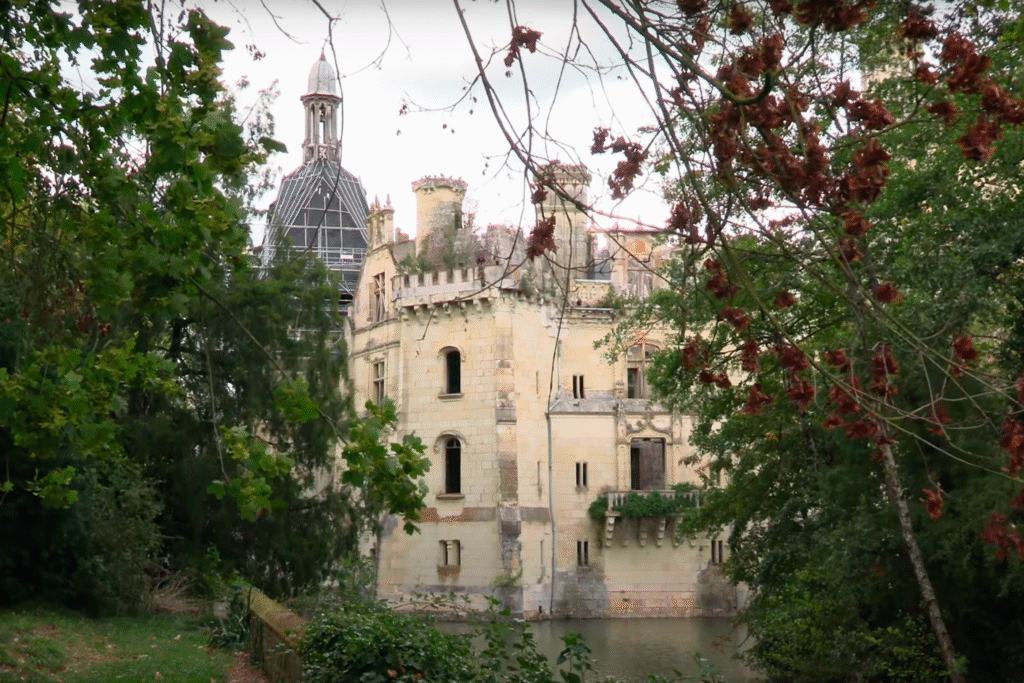
If you only follow the usual visitor’s path at La Mothe-Chandeniers, you’ll have a memorable day. But it’s the little extras that make the place stick in your memory. My favorite moments have always happened a little off-script.
One of the best things you can do is check the calendar for special events. A few times each year, the castle hosts night visits—picture wandering the ruins by lantern light, shadows flickering across the stone. It feels less like a guided tour and more like a secret shared among friends. I remember standing quietly in the old chapel one evening, listening to live music echo through half-ruined walls. You don’t get that kind of magic on a typical afternoon.
Crowdfunding hasn’t just saved the castle—it’s brought an ongoing stream of new energy. I’ve met owners from all over Europe who come for hands-on restoration weekends. Sometimes you’ll find volunteers repainting window frames or clearing brush. They’re friendly, happy to chat, and full of stories about hidden details you might otherwise miss. If you’re curious about getting involved, ask at the ticket booth—sometimes there are opportunities for visitors to pitch in, even just for an hour.
Keep your eyes peeled for little surprises: pop-up art installations in the gardens, food trucks serving local specialties, or a photography contest posted on the message board. And don’t underestimate the views. The classic postcard shot is from across the moat, but locals in the know head out into the fields at sunset—the castle looks its most mysterious when the last light hits the towers and the mist begins to gather.
If you want to leave with more than just photos, check if they’re offering temporary “owner for a day” passes. It’s a fun way to dip your toes into the restoration project, and you’ll see parts of the grounds off-limits to most visitors.
There’s a sense here that anything can happen. Even after several visits, I still find something unexpected every time—sometimes as small as a new wildflower in the cracks, sometimes as grand as a concert in the ruins.

Suggested Itineraries
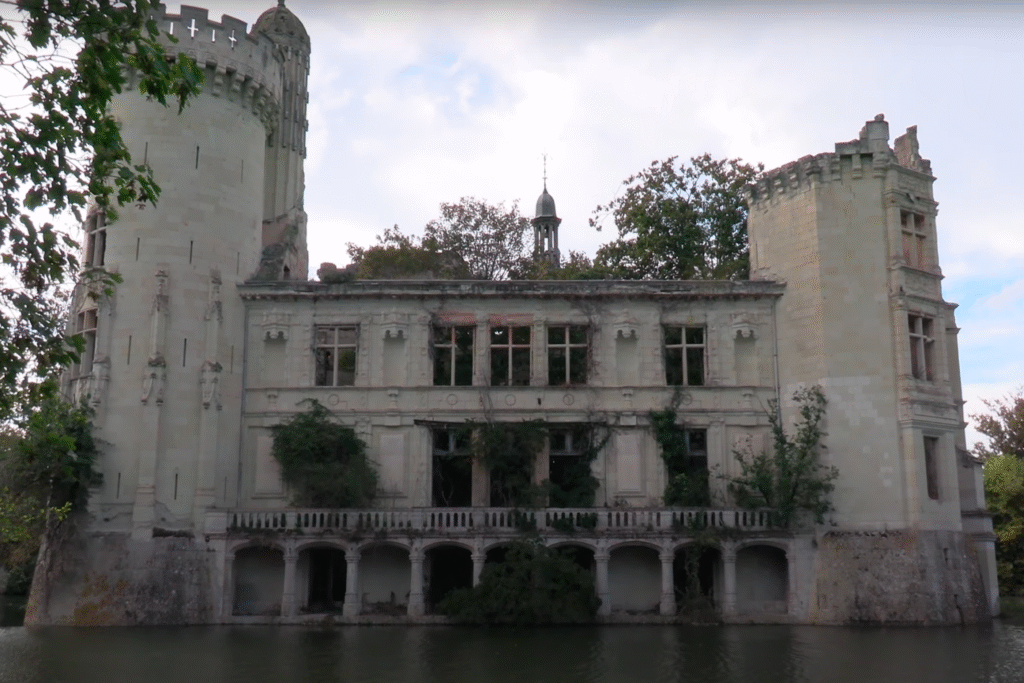
Half-Day Visit: The Essentials
If you’re short on time, don’t worry—you can get a real feel for La Mothe-Chandeniers in just a few hours. Arrive early if you can; the morning light on the castle and moat is stunning. Cross the bridge, take a slow loop around the grounds, and linger on the far side where the castle’s reflection in the water is most striking. Pop into the chapel if it’s open. Spend time exploring the gardens and reading the storyboards dotted around. Don’t forget to peek through the ruins where the ballroom used to be. Grab a coffee or quick snack at the café before you head out.
Full-Day Deep Dive: Castle Life & Local Flavor
With a whole day, you can relax into the pace here. Arrive mid-morning and start with the main circuit around the castle and through the wild gardens. Join a guided tour if one’s available; you’ll hear the kinds of stories you won’t find on the website. Bring or buy lunch and enjoy it at one of the picnic tables with a moat view—watch for herons and dragonflies. In the afternoon, wander further afield: the surrounding woodland paths are peaceful, and you might spot deer or foxes if you’re quiet. Check the schedule for workshops or art installations—sometimes there’s an interactive event or a local maker showing their craft. Before leaving, take a stroll out to the fields behind the castle for that iconic sunset view.
Weekend Adventure: Castles, Wine & Villages
If you have a weekend, base yourself in Loudun or a nearby village. Start Saturday with a slow morning at La Mothe-Chandeniers, maybe even sign up for a restoration session if you’re feeling hands-on. In the afternoon, head out to explore Château de Brézé (famous for its underground passages) or visit the majestic Abbey of Fontevraud. Sunday is perfect for a wine tasting tour—this region is full of small, family-run vineyards that welcome visitors. You’ll find open-air markets in local towns, especially during spring and summer, where you can pick up cheese, bread, and produce for a real picnic. Finish with a quiet evening walk around the castle grounds when most of the crowds have left. It’s a completely different atmosphere after hours—almost as if the castle belongs to you.

What’s Nearby: Top Attractions in the Area

After you’ve had your fill of La Mothe-Chandeniers, don’t rush off. The surroundings offer more than you might expect—and you won’t need to drive far.
Château de Brézé
I’d heard about Brézé’s underground world before visiting, but it still surprised me. It’s less than a half-hour from La Mothe-Chandeniers, and honestly, I spent as much time below ground as above. There’s a network of tunnels and cellars, plus a deep dry moat you can walk right through. The château itself feels grand and a bit lived-in, and guides are happy to answer even the oddest questions.
Abbaye de Fontevraud
A classic if you’re a history lover. This abbey is impressive in scale and atmosphere, but what really struck me was the silence inside the cloisters. You’ll find the tombs of Eleanor of Aquitaine and Richard the Lionheart here—so if you like stories of medieval intrigue, you’ll want to linger. The on-site café is actually quite good for a snack, and there’s usually a contemporary art exhibition happening somewhere on the grounds.
Loudun
Loudun doesn’t look flashy from the road, but I stopped here for a coffee and ended up losing an entire afternoon. The old stone keep is worth a climb for the views, and the market square feels like the beating heart of the town. I wandered into a bakery that smelled like heaven and left with more pastries than I meant to buy. Locals here are curious and warm—don’t be shy about asking for tips.
Saumur & Loire Valley Vineyards
If you love wine, Saumur is less than 40 minutes away. The town itself has a cheerful buzz and a beautiful riverside setting. You can join a wine tasting at one of the limestone cave wineries or rent bikes for a gentle ride through the vineyards. There’s also the Mushroom Museum nearby, which sounds quirky—and it is—but I ended up learning more than I expected.
A final suggestion: Even if you just have a few hours, take a detour down one of the little country roads between these spots. This region rewards those who follow their curiosity. Sometimes the best find is a hidden picnic spot or an unexpected view of the château through a gap in the hedges.

FAQ (Practical Reader Questions)
Is parking available at La Mothe-Chandeniers?
Yes, and it’s free. There’s a grass parking area just outside the main gate. On busy weekends or event days, you might need to park along the road and walk a little, but I’ve never had trouble finding a spot.
Can I bring my dog?
Absolutely. Dogs are welcome on a leash throughout the grounds. Just keep an eye on them near the water and inside any indoor spaces.
Are there guided tours in English?
Sometimes, especially during holidays or special weekends. Most of the signage is in French and English, and the staff are used to international visitors. If you’re hoping for a tour in English, email ahead and ask what’s scheduled.
Can I take photos or fly a drone?
Photography for personal use is encouraged—there’s a lot to capture here. For drones, you’ll need to ask permission in advance, especially if restoration work is ongoing or there’s an event happening.
Are picnics allowed?
Yes! There are picnic tables around the castle, and you’re welcome to bring your own food. Just take your trash with you and leave things as you found them.
What about accessibility?
Some paths are uneven, and a few areas are tricky with a stroller or wheelchair. Still, the main walkways and gardens are manageable for most. Staff can advise you when you arrive.
Is it possible to visit year-round?
Most of the year, yes, but the castle closes for a few weeks in deep winter and during major restoration projects. Check the website before planning an off-season trip.
Do I need to book tickets in advance?
Booking online is recommended, especially in spring, summer, or for special events. Walk-ins are possible on quieter days, but you risk being turned away if there’s a big crowd.
Can I become an owner?
You can! Shares are sometimes available for purchase at the gift shop or online, making you part of the restoration project and giving you a stake in the castle’s future.
How do I contact someone if I’ve lost something?
The staff at the entrance are helpful and can look after lost-and-found items. There’s also a contact form on the official website for follow-up after your visit.
If you have a question that isn’t covered here, don’t hesitate to ask at the gate or drop them a message online—people here are genuinely happy to help.

Final Reflections
It’s hard to put into words what makes La Mothe-Chandeniers so memorable. This isn’t a castle that’s been polished and restored to perfection. It’s rough around the edges, unpredictable, and—if I’m honest—that’s exactly why I keep thinking about it long after my visits.
Standing by the moat near sunset, I’ve felt a quiet that you don’t get at most big tourist sights. Sometimes, a volunteer will wave hello as they haul gardening tools across a path. Other days, you’ll see a family unpacking a picnic or a group of new co-owners looking for “their” bit of the castle wall. No visit here feels the same as the last, and there’s a sense that if you came back next year, you’d find something new growing or repaired.
If you want to see a place where history is still being written, this is it. La Mothe-Chandeniers isn’t finished—it’s changing, season by season, thanks to the people who show up and care. I can’t tell you what you’ll find when you go, but I can promise it won’t be dull.
So if you’ve ever wandered through an old ruin and wondered what it would be like to help bring it back to life, put this castle on your list. Maybe you’ll join the restoration, maybe you’ll just walk the paths and dream a little. Either way, you’ll be part of the story.
💬 Have you already spent time at La Mothe-Chandeniers? Maybe you found a hidden corner I missed, or made a memory you want to share. Leave a comment, send a message, or tag your photos @CastleQuestChronicles—I’d genuinely love to hear your stories.
👉 Looking for more? Discover the strength of Castillo San Felipe de Barajas, Colombia’s defiant coastal sentinel, or the elegance of Larnach Castle, perched above the sea in New Zealand’s far south.
🏰✨ If this article sparked your curiosity about the castles, follow along. We are on Instagram, Pinterest, Facebook, and X, too. More castles (and more stories) are just around the bend.
Explore all our castle adventures here!



